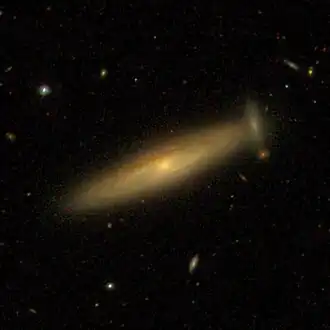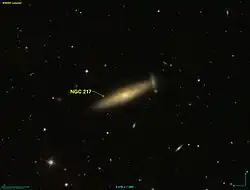NGC 217
| NGC 217 | |
|---|---|
 SDSS view of NGC 217 | |
| Observation data (J2000 epoch) | |
| Constellation | Cetus |
| Right ascension | 00h 41m 33.9s[1] |
| Declination | −10° 01′ 17″[1] |
| Redshift | 0.013262[1] |
| Distance | 178 Mly[2] |
| Apparent magnitude (V) | 13.0g[1] |
| Characteristics | |
| Type | S0/a[1] |
| Apparent size (V) | 2.05' × 0.68'[1] |
| Other designations | |
| MCG -02-02-085, 2MASX J00413390-1001169, 2MASXi J0041339-100117, IRAS F00390-1017, 6dF J0041339-100117, PGC 2482.[1] | |
NGC 217 is a spiral or lenticular galaxy located approximately 178 light-years from the Solar System[2] in the constellation Cetus. It was discovered on November 28, 1785 by William Herschel.[3]

See also
References
- ^ a b c d e f g "NASA/IPAC Extragalactic Database". Results for NGC 0217. Retrieved 2016-09-02.
- ^ a b An object's distance from Earth can be determined using Hubble's law: v=Ho is Hubble's constant (70±5 (km/s)/Mpc). The relative uncertainty Δd/d divided by the distance is equal to the sum of the relative uncertainties of the velocity and v=Ho
- ^ "New General Catalog Objects: NGC 200 - 249". Cseligman. Retrieved September 15, 2016.
External links
 Media related to NGC 217 at Wikimedia Commons
Media related to NGC 217 at Wikimedia Commons- NGC 217 on WikiSky: DSS2, SDSS, GALEX, IRAS, Hydrogen α, X-Ray, Astrophoto, Sky Map, Articles and images
- SEDS